 Like
pieces coming together in a puzzle, that's how
our family boat building project is coming together.
My grandson Christopher's, along with my brother
Steve's good eye for fair curves keeps the hull
looking good. A fair or a sweet curve, as I like
to to call them, is a result of those long sweeping
compound sweeping, well proportioned curves, when
wood is bent around a form. It is something that
not only boat builders strive for, but also designers
of cars and airplanes. Like
pieces coming together in a puzzle, that's how
our family boat building project is coming together.
My grandson Christopher's, along with my brother
Steve's good eye for fair curves keeps the hull
looking good. A fair or a sweet curve, as I like
to to call them, is a result of those long sweeping
compound sweeping, well proportioned curves, when
wood is bent around a form. It is something that
not only boat builders strive for, but also designers
of cars and airplanes. |
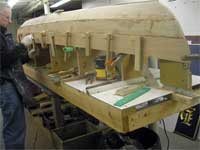 With
only three planks on each side versus nine planks
on each side on the last boat we built, the planking
of the hull has gone along very quickly. The use
of simple home made clamps keeps the construction
costs in hand. With
only three planks on each side versus nine planks
on each side on the last boat we built, the planking
of the hull has gone along very quickly. The use
of simple home made clamps keeps the construction
costs in hand. |
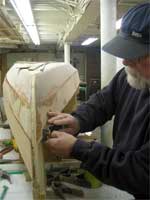 He's
a shot of my favorite brother Steve planning a
bevel gain into a strake or plank. He's
a shot of my favorite brother Steve planning a
bevel gain into a strake or plank. |
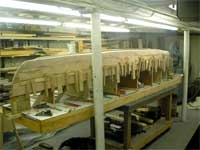 This
is a shot of the last plank being clamped in place.
It won't be long an before we'll be pulling the
hull off the molds. This
is a shot of the last plank being clamped in place.
It won't be long an before we'll be pulling the
hull off the molds. |
 Attaching
the cutwater or false stem to the bow. The cutwater
bears the brunt when a hull collides with another
boat or object. Attaching
the cutwater or false stem to the bow. The cutwater
bears the brunt when a hull collides with another
boat or object. |
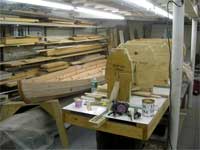 The
hull is finally pulled off of the molds. The
hull is finally pulled off of the molds. |
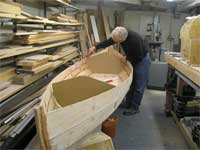 Cardboard
templets are made of the bulkheads of the water
tight compartments. The overall length of the
hull is 12'6". With the bulkheads in place,
the over all length of the cockpit is about 6'6",
large enough for an adult and a grand child. Cardboard
templets are made of the bulkheads of the water
tight compartments. The overall length of the
hull is 12'6". With the bulkheads in place,
the over all length of the cockpit is about 6'6",
large enough for an adult and a grand child. |
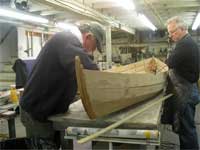 Before
any trim work can be done any excess epoxy must
be softened with a heat gun and scraped away.
It's along and tedious job. You have to remind
yourself to remove the excess epoxy squeeze out
as you install each plank. Here I'm lecturing
Steve about how much time it will take to remove
all this crap. Before
any trim work can be done any excess epoxy must
be softened with a heat gun and scraped away.
It's along and tedious job. You have to remind
yourself to remove the excess epoxy squeeze out
as you install each plank. Here I'm lecturing
Steve about how much time it will take to remove
all this crap. |
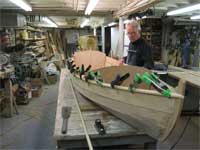 Finally
the bulkheads are epoxied in place and the oak
rub rails are shaped and installed in place. You
can't have too many clamps. Finally
the bulkheads are epoxied in place and the oak
rub rails are shaped and installed in place. You
can't have too many clamps.
|
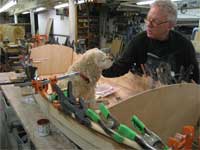 Here's
Rugs, the ever faithful Cocker Spaniel, trying
out the cockpit for size. Here's
Rugs, the ever faithful Cocker Spaniel, trying
out the cockpit for size.
|
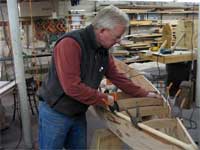 Next
up is fabricating the deck beams. It is a very
slow job complicated by the computing of the deck
camber. Next
up is fabricating the deck beams. It is a very
slow job complicated by the computing of the deck
camber.
|
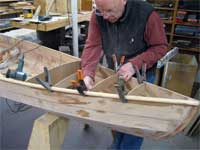 Very,
V e r y , s l o o o o w Very,
V e r y , s l o o o o w
|
| 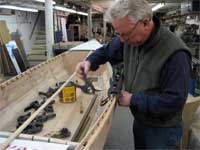 Here we're attaching the inwales, not to be
confused with the outwales. It's kind of sounds
like a inny belly button or an outty belly button.
Outwales are actually the rub rails of the hull
and the strip of wood that makes up the inwales
provides additional stiffness to the hull. The
small spacer blocks allow water to be drained
out of the canoe when it is?tipped on it's side
and if I must say, give the boat a very traditional
look.
Here we're attaching the inwales, not to be
confused with the outwales. It's kind of sounds
like a inny belly button or an outty belly button.
Outwales are actually the rub rails of the hull
and the strip of wood that makes up the inwales
provides additional stiffness to the hull. The
small spacer blocks allow water to be drained
out of the canoe when it is?tipped on it's side
and if I must say, give the boat a very traditional
look.
|
|  Grandson
Christopher and Rugs are making believe that
my stories are really funny. Rugs is giving
me the look similar to my wife when she tires
of my humor . . . . Grandson
Christopher and Rugs are making believe that
my stories are really funny. Rugs is giving
me the look similar to my wife when she tires
of my humor . . . .
|
|  Here
is brother Steve painting the inside of the
watertight storage compartments. Steve and I
keep the conversation moving discussing boats,
relatives, lobster rolls, Dave Mcdonald, the
treasure on Snake Island, relatives, the Beachmont
Yacht Club (worth the visit!!), boats, wives,
but never politics. The discussion of politics
are left to Brother Tony who was exiled to Minnesota
several years ago because he couldn't stand
being so close to Ted Kennedy. Here
is brother Steve painting the inside of the
watertight storage compartments. Steve and I
keep the conversation moving discussing boats,
relatives, lobster rolls, Dave Mcdonald, the
treasure on Snake Island, relatives, the Beachmont
Yacht Club (worth the visit!!), boats, wives,
but never politics. The discussion of politics
are left to Brother Tony who was exiled to Minnesota
several years ago because he couldn't stand
being so close to Ted Kennedy. |
| 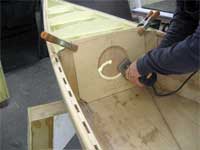 Here
I'm using a plywood template, along with a small
router with a pilot bit to cut the circular
hole for the inspection port or access hatch
to the water tight compartment. Here
I'm using a plywood template, along with a small
router with a pilot bit to cut the circular
hole for the inspection port or access hatch
to the water tight compartment.
|
| 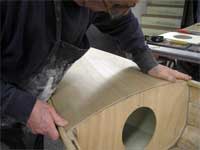 Next
comes the fitting of the deck, actually two
decks, one for the bow and one for the stern
water tight compartments. This was a very slow
process making a templet and a lot of cutting
and hand planning to get an accurate fit. My
Italian grandfather used to say "measure
ten times and cut once . . . . . . and he was
always right! Next
comes the fitting of the deck, actually two
decks, one for the bow and one for the stern
water tight compartments. This was a very slow
process making a templet and a lot of cutting
and hand planning to get an accurate fit. My
Italian grandfather used to say "measure
ten times and cut once . . . . . . and he was
always right!
|
|  Clamping
was another matter. The deck is actually bonded
in place using West System Epoxy, combined with
a cabosil thickening agent. I devised a Rube
Goldberg series of hold down strips in conjunction
to a bunch of spring clamps. A test or dry fit
seemed to work very well. Clamping
was another matter. The deck is actually bonded
in place using West System Epoxy, combined with
a cabosil thickening agent. I devised a Rube
Goldberg series of hold down strips in conjunction
to a bunch of spring clamps. A test or dry fit
seemed to work very well.
|
| 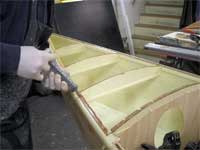 After
the dry fit, we applied thickened epoxy with
a plastic syringe. The deck had to be structurally
sound and also water tight. There are no mechanical
fasteners such as screws or nails used in the
fastening of the deck to the hull. After
the dry fit, we applied thickened epoxy with
a plastic syringe. The deck had to be structurally
sound and also water tight. There are no mechanical
fasteners such as screws or nails used in the
fastening of the deck to the hull.
|
| 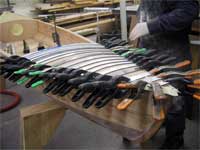 Can
a man really have enough clamps?? Can a woman
have enough shoes or handbags?? Can
a man really have enough clamps?? Can a woman
have enough shoes or handbags??
|
| 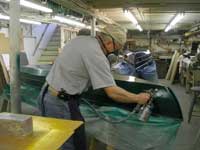 Richard
did an amazing job on the paint. Richard
did an amazing job on the paint.
|

Click
here for Richard's original Indian Girl Post
Click
here to buy plans for Indian Girl |